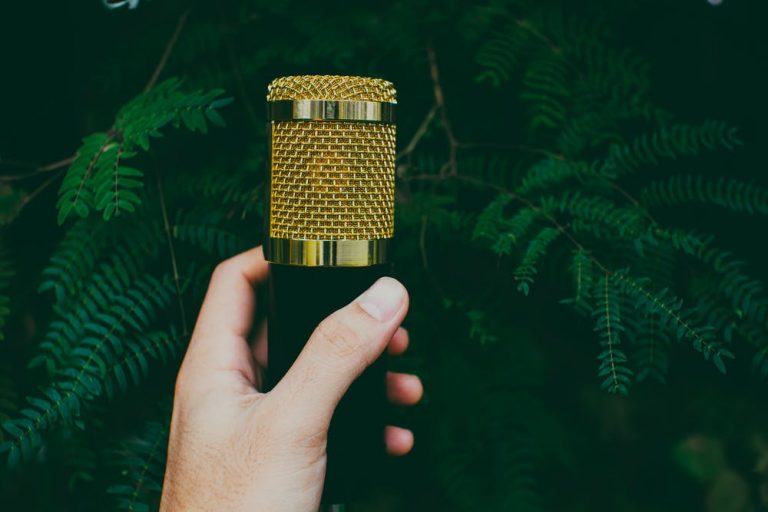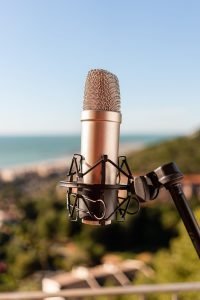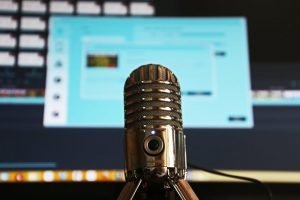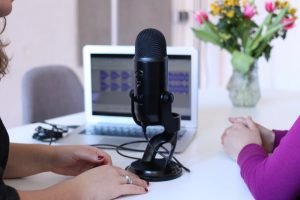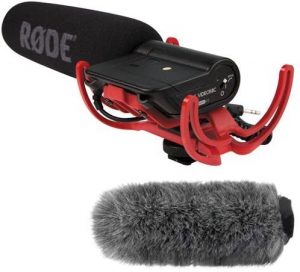What is the best microphone for recording nature? Why does it matter?
You may have been itching to go out and explore the wonderful world of soundscapes, but have been stuck wondering what is a good mic for recording nature.
You might be thinking about buying one at this very moment!
Well, don’t worry — we are here to help you find your perfect match and get you back outdoors ASAP.
We’ll let you know what’s good, and what’s bad, about each microphone so that you can determine whether or not it’s the right tool for your recording ambitions.
We’ll also talk about how each microphone works, and which models are worth the purchase price.
All of our reviews below will be based on our own experiences with each model of the microphone.
Table of Contents
How to Choose a Microphone for Recording Nature
Natural Environment
The first thing to think about when buying a microphone is the environment you plan on recording in.
If you plan on recording in an area with a lot of background noise, or if wind and other factors are going to be present, make sure that the microphone can handle these conditions before purchase.
Microphone Patterns
Microphones that have a cardioid polar pattern pick up audio sources from the front and sides of the mic better than those with omnidirectional or figure-8 patterns allows for more accurate sound recordings, especially in very noisy environments.
Frequency Response
Make sure that your microphone has a high enough frequency response for what you want to record so that you can capture both high and low frequency sounds accurately (usually at least 20Hz-20kHz and 200Hz-10kHz).
SPL Capacity
A microphone should also have a high SPL handling capacity so that it can handle the sound pressure levels that frequently occur when recording wildlife.
Portability
The microphone should also be easy to carry around with you when you are recording in the wild.
We recommend at least a clip-on microphone to prevent your mic from getting damaged, although most microphones will hold up quite well if they aren’t dropped or mishandled.
Low Self Noise
The microphone should have a low self-noise level. If the self-noise is too high, it will be hard to separate the sounds you want to record from the microphone itself.
The best choice for most people is an internal microphone because they are often less expensive, require no additional equipment, and are of good quality.
External Phone microphones are also easy to connect to many digital recorders if you want a more advanced sound setup.
We’ve reviewed seven different microphones so that you can make an informed decision.
——————————————————————————————————————————————-
Related Guides:
- Best Shotgun Mics Reviewed
- Best Boom Mics
- Best Microphone Boom Arm Reviewed
- Boom Poles for FilmMaking Guide
——————————————————————————————————————————————-
6 Best Microphones For Recording Nature Outdoors
Last update on 2024-10-20 / Affiliate links / Images from Amazon Product Advertising API
1. Rode VideoMic
No products found.
I use a Rode VideoMic for recording outdoors and it works great. It’s affordable, compact, lightweight and has a good sound quality that can capture an interview or voiceover in a noisy area without having to worry about wind noise. Many kids are using this microphone for recording nature and it’s really bad for people who don’t know a thing about audio, you should use it only when you are going to be too far from your subject/interviewee
If you’re going to be in a very quiet place that has few or no background noises, then go for an affordable one like the Rode VideoMic.
2. Rode NTG4+
- Broadcast sound quality
- Low noise circuitry
- Internal rechargeable lithium battery, supplying over 150 hours operation
- Fully charged in under two hours via MicroUSB
- English (Publication Language)
Last update on 2024-10-20 / Affiliate links / Images from Amazon Product Advertising API
Rode NTG4+ Shotgun Microphone Rode NTG4+ Shotgun Mic is the ultimate video camera microphone for serious filmmakers. It is a waterproof microphone. The NTG4+ provides very low handling noise while maintaining audio quality. Also, less electronic noise is present when this mic is used. The designers of this product are so confident of its durability, they have supplied a comparison with the lens cap in the manual. That gives an idea of how tough it’s made. This microphone is made to last and it comes with a 10-year warranty.
This mic has a low-cut filter that will cut down the popping sounds of air-release caused by the recording itself. This will also reduce any interference that may come from car horns or any other nearby sources of sound. This is an absolute must if you are recording in areas where there are lots of wind and weather elements. You can set this in your camera in the audio recorder settings so your repeated take won’t have this sound too loud.
3. Sennheiser MKH416-P48
- Compact pressure-gradient microphone with short interference tube for film, radio and television
- Rugged and highly immune to humiditiy due to its RF condenser design, making it ideal for outside applications
- Featuring high directivity, low self noise, high consonant articulation and feedback rejection
- Transformerless and fully floating balanced output
- Matte black all-metal body
Last update on 2024-10-22 / Affiliate links / Images from Amazon Product Advertising API
The Sennheiser MKH416-P4800 is the best choice for recording nature indoors or outdoors. It boasts a natural and realistic sound with low noise. This microphone has an impressive frequency response of 20 Hz to 20 kHz and 124 dB dynamic range to accurately capture detail in high and low frequencies. It is highly directional, which means it doesn’t pick up sounds from any direction (Omni-directional) but rather records from one specific direction, meaning there will be less background noise compared to shotgun microphones including wind when outdoors. The Sennheiser MKH416-P4800 also comes with a Rycote Windshield Set that lets you get close to your subject while isolating the subject’s voice from reverberation and other surrounding effects.
4. Sennheiser MKE 600
- Ideal video camera/camcorder microphone: Able to handle the most demanding filmic challenges
- High directivity: Picks up sounds coming from the direction in which the camera is pointing and effectively attenuates noise coming from the sides and...
- Switchable "Low Cut" filter: Minimizes wind noise
- Phantom or battery powering: Because some video cameras/ camcorders do not provide phantom power
- Supplied with foam windshield and shock mount
Last update on 2024-10-20 / Affiliate links / Images from Amazon Product Advertising API
The shotgun microphone is used in recording nature to get the sounds of the forest, birds, or other animals while blocking out unwanted noise. For example, if you are recording a bird in a forest, using a shotgun mic will give you crystal clear audio of the bird’s song with minimal interference by leaves rustling in the wind.
The Sennheiser MKE600 Shotgun Mic is designed to be used when tracking wildlife and other outside recordings. It has multiple features that make it useful for these kinds of tasks: it can direct sound towards its desired target with its highly directional pickup pattern; you can record both high and low frequencies; it is compact and lightweight but made strong enough to withstand weather conditions, and it comes with a Rycote windscreen that can help reduce unnecessary noise.
The flex arm is collapsible so you can fit it in your bag and bring it with you anywhere you go. Its metal construction makes it hard to break, and its premium construction can withstand any type of weather condition. Its directional characteristics make the microphone useful for recording outdoors and indoors, while its flexible design allows the microphone to be used comfortably from a wide range of heights.
5. Rode Stereo VideoMic X
- Acoustically matched true condenser capsules
- Rycote Lyre onboard shock mounting
- Balanced professional XLR output
Last update on 2024-10-20 / Affiliate links / Images from Amazon Product Advertising API
The Rode Stereo VideoMic X is a shotgun microphone that has a stereo condenser and shotgun patterns. It is a powerful microphone with two integrated pickup aids to help reduce unwanted noise in any setting. It’s helpful for outdoor shots with lots of background noise, which is where the stereo recording pattern comes in handy. The mic has an internal pop filter and low cut filter to help eliminate those pops or crackles from being recorded accidentally so you just have pure clear audio without any interference.
This mic is very sensitive to sound which helps with picking up all those sounds of nature like birds or wind in the distance while still picking up your foreground audio like a bird chirping nearby. Its dimensions are: 5 inches long by 2 inches wide by 2.5 inches tall, and it weighs 3.3 pounds.
6. Rode NTG3-C
Last update on 2024-10-20 / Affiliate links / Images from Amazon Product Advertising API
Although this one is not made by Rode, it’s a great microphone for recording outdoors. The HC3-BK is specifically designed to record natural sound in outdoor environments, such as nature, macro audio recording, and wildlife sound recording. This product comes with an ergonomic body design which makes it more comfortable to hold than other similar products on the market today. The design also protects the microphone capsule from damage.
This product is also very durable and can be submerged underwater for up to 1m for 30 minutes. It can withstand extreme weather conditions and high temperatures, which makes it an ideal tool for outdoor recording.
FAQs
What type of mic is best suited for outdoor use?
A condenser mic is best suited for outdoor use. The other options are not as good because they are sensitive to moisture and will also pick up background noises.
How do you record high-quality nature sounds?
It is best to record nature sounds in a secluded area or near a busy street because it will have less noise interference. You can use one of your phone’s camera app to record the sound.
How do I record good audio outside?
You can take a recording device and leave it out for 24 hours or until it picks up the sound you need to record.
FAQ:
Q: What is the best microphone for nature recording?
A: The Rhodes NT4 is a solid microphone trusted to produce pristine audio quality. It has proven to have more pick-up distance than most other microphones and is therefore widely used in field recording to capture nature sounds.
Q: What microphone do I need for field recording?
A: If you need to zoom in on a sound, you need a parabolic dish (see below). Shotgun mics tend to be very sensitive to wind, so they will need some form of wind protection. Examples of shotgun mics commonly used by field recordists include Rode NTG-1, Rode NTG-2, Rode NTG4+, Sennheiser MKE 600, Sennheiser MKH416, Audio Technica AT 875R:
Q: Are microphones good for recording loud sounds?
A: They’re great for subtle to medium loud sounds but they aren’t designed for seriously loud sources. Mics such as the DPA 4062 (or its newer equivalent) are much better suited for recording loud engines or explosions. One other thing that pertains to audio quality is frequency response.
Q: What kind of microphone do you use to record birds?
A: If you want to record a bird in front of you or get closer to a person speaking, while reducing other noises, you would use a shotgun mic. One drawback to shotgun mics relative to others is that they are more sensitive to wind noise. Four basic microphone patterns.
